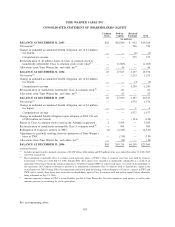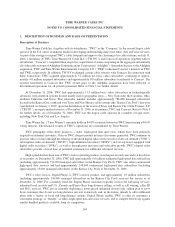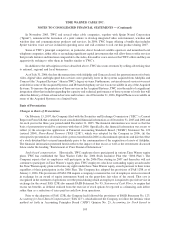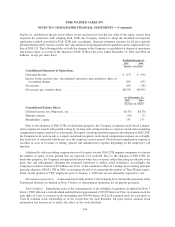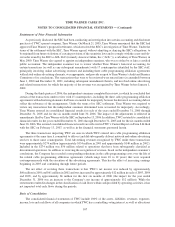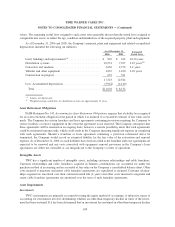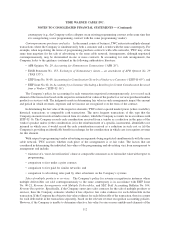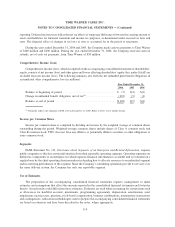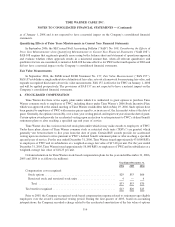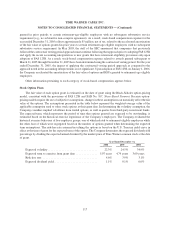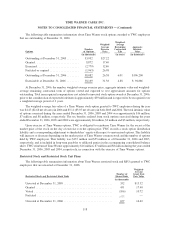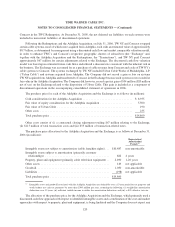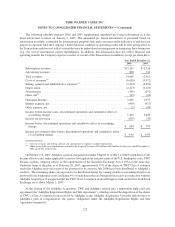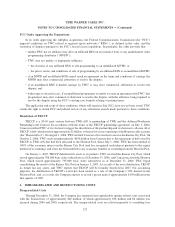Time Warner Cable 2006 Annual Report Download - page 118
Download and view the complete annual report
Please find page 118 of the 2006 Time Warner Cable annual report below. You can navigate through the pages in the report by either clicking on the pages listed below, or by using the keyword search tool below to find specific information within the annual report.transaction, the Company recognizes revenue on a straight-line basis over the term of the agreement. For example,
the Company sells cable, Digital Phone and high-speed data services to subscribers in a bundled package at a rate
lower than if the subscriber purchases each product on an individual basis. Subscription revenues received from
such subscribers are allocated to each product in a pro-rata manner based on the fair value of each of the respective
services.
Purchases of multiple products or services. The Company’s policy for cost recognition in instances where
multiple products or services are purchased contemporaneously from the same counterparty is consistent with the
Company’s policy for the sale of multiple deliverables to a customer. Specifically, if the Company enters into a
contract for the purchase of multiple products or services, the Company evaluates whether it has fair value evidence
for each product or service being purchased. If the Company has fair value evidence for each product or service
being purchased, it accounts for each separately, based on the relevant cost recognition accounting policies.
However, if the Company is unable to determine fair value for one or more of the purchased elements, the Company
would recognize the cost of the transaction on a straight-line basis over the term of the agreement.
This policy also would apply in instances where the Company settles a dispute at the same time the Company
purchases a product or service from that same counterparty. For example, the Company may settle a dispute on an
existing programming contract with a programming vendor at the same time that it is renegotiating a new
programming contract with the same programming vendor. Because the Company is negotiating both the settlement
of the dispute and a new programming contract, each of the elements should be accounted for at fair value. The
amount allocated to the settlement of the dispute would be recognized immediately, whereas the amount allocated
to the new programming contract would be accounted for prospectively, consistent with the accounting for other
similar programming agreements.
Gross Versus Net Revenue Recognition
In the normal course of business, TWC acts as an intermediary or agent with respect to payments received from
third parties. For example, TWC collects taxes on behalf of franchising authorities. The accounting issue
encountered in these arrangements is whether TWC should report revenue based on the gross amount billed to
the ultimate customer or on the net amount received from the customer after payments to franchising authorities.
The Company has determined that these amounts should be reported on a gross basis.
Determining whether revenue should be reported gross or net is based on an assessment of whether TWC is
acting as the principal in a transaction or acting as an agent in a transaction. To the extent TWC acts as a principal in
a transaction, TWC reports as revenue the payments received on a gross basis. To the extent TWC acts as an agent in
a transaction, TWC reports as revenue the payments received, less commissions and other payments to third parties
on a net basis. The determination of whether TWC serves as principal or agent in a transaction involves judgment
and is based on an evaluation of the terms of an arrangement. In determining whether TWC serves as principal or
agent in these arrangements, TWC follows the guidance in Emerging Issues Task Force (“EITF”) Issue No. 99-19,
Reporting Revenue Gross as a Principal versus Net as an Agent.
Income Taxes
TWC is not a separate taxable entity for U.S. federal and various state income tax purposes and its results are
included in the consolidated U.S. federal and certain state income tax returns of Time Warner. The income tax
benefits and provisions, related tax payments, and current and deferred tax balances have been prepared as if TWC
operated as a stand-alone taxpayer for all periods presented in accordance with the tax sharing arrangement between
TWC and Time Warner. Under the tax sharing arrangement, TWC is obligated to make tax sharing payments to
Time Warner as if it were a separate payer. Income taxes are provided using the asset and liability method prescribed
by FASB Statement No. 109, Accounting for Income Taxes. Under this method, income taxes (i.e., deferred tax
assets, deferred tax liabilities, taxes currently payable/refunds receivable and tax expense) are recorded based on
amounts refundable or payable in the current year and include the results of any difference between GAAP and tax
113
TIME WARNER CABLE INC.
NOTES TO CONSOLIDATED FINANCIAL STATEMENTS — (Continued)


